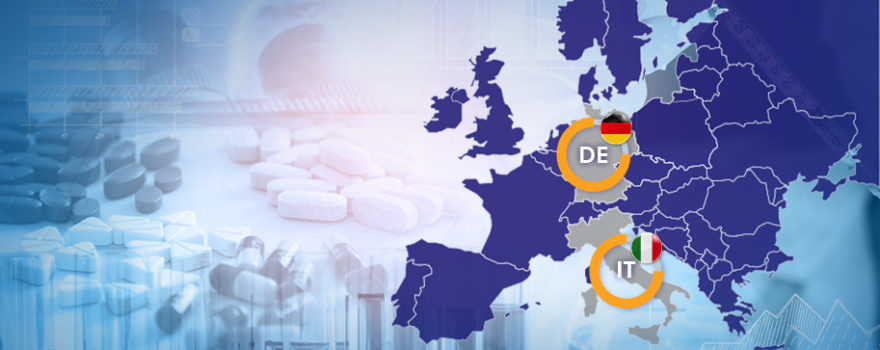
The pharmaceutical industry is a pillar of the European manufacturing sector, an excellence at global level. Among the countries competing for leadership in the sector are Italy and Germany, at the forefront of research, development and production of new medicines.
What determines the volume of R&D investment is the pharmaceutical sector’s ability to attract new capital, due to the sector’s solidity, reliability and broad growth prospects.
Germany: research and development
The German pharmaceutical industry plays a key role in the research and development of innovative medicines, with an investment volume that is growing by virtue of concrete achievements: production of new medicines, patent filings, execution of clinical trials.
In 2020, Germany contributed 4.5 % to global medicine production, rising to 5.2 % in 2021. The increase in demand was mainly driven by Covid-19 vaccines, but it is estimated that demographic trends will play a decisive role in the coming years. The gradual increase in average age, in fact, will push the accelerator on medical therapies and the production of medicines to combat the most widespread chronic diseases in the elderly population.
Italy: robustness and innovation
Italy, for its part, «has always been attractive for investment, with a solid pharmaceutical industry and a strong base for innovation», as Nathalie Moll, director of EFPIA, recalled in an interview with Ansa. The pharmaceutical industry, 85% of which is export-oriented, is a strategic sector of the Italian economy, with a high level of employment, a high rate of specialisation and a marked propensity for innovation.
According to Farmindustria, digital innovation, in recent years, has had a positive spin-off both in terms of quality and in terms of productivity and supply to the consumer. The benefits of this development are reflected not only in the country’s economy, but also in the quality of life, whose average lifespan is also increasing thanks to the introduction of new medicines.
Attracting new capital to produce next-generation medicines
According to the ‘Patient WAIT’ ranking, compiled by EFPIA-European Federation of Pharmaceutical Industries and Associations, Germany and Italy are the European countries where patients have to wait the shortest time to take advantage of new generation medicines, once approved by the EMA.
There are countries, such as Romania, where more than two years elapse between the scientific evaluation and the actual placing of the medicine on the market. For Italian patients, the wait is around 14 months, for German patients it is as short as four months. These timeframes not only affect public health, but also strongly condition the entry of new capital, which is essential to boost research and the development of innovative therapies.
New regulatory interventions to ensure equitable access to medicines
During the annual PGEU (Pharmaceutical group of European Union) Symposium in Rome on 15 June, the future of pharmaceutical legislation and the need to develop regulatory interventions «to ensure fair access to safe, effective and quality medicines for all European citizens» was debated, as Roberto Tobia, Federfarma’s national secretary and current president of the Pharmaceutical Group of European Union, emphasised.
Tackling the problem of medicine shortages has long been a priority for EU Member States. However, the health emergency has made it abundantly clear how important it is for Europe to assert its leadership in the pharmaceutical field and to gain global autonomy, no longer having to depend on third countries for the supply of medicines and raw materials for production. Establishing clear rules and cutting red tape would also allow companies to be more competitive on the market, reducing the need for foreign investment and increasing the inflow of real capital from exports. In a country like Italy, where the pharmaceutical industry is a strategic sector, with a strong propensity for innovation and export growth above the European average (+74% in the five-year period 2015-2020, according to the Farmindustria Report), the possibilities for development to the benefit of the population would be enormous. «But to make them concrete», recalls the Association of Pharmaceutical Companies, «a new organisation is essential: the speed with which research progress reaches patients is no longer ‘only’ a scientific issue, but increasingly one of planning, rules, skills, decision-making processes».